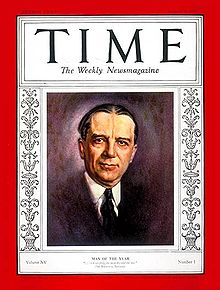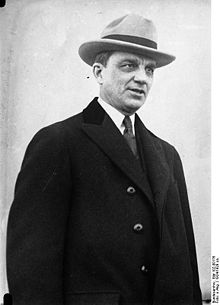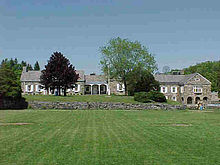- Owen D. Young
-
 Young as Time Person of the Year
Young as Time Person of the Year
Owen D. Young (October 27, 1874 - July 11, 1962) was an American industrialist, businessman, lawyer and diplomat at the Second Reparations Conference (SRC) in 1929, as a member of the German Reparations International Commission.
He is best known for his SRC diplomacy and for founding the Radio Corporation of America. Young founded RCA as a subsidiary of General Electric in 1919; he became its first chairman and continued in that position until 1929.
Contents
Biography
Owen D. Young [1] was born in 1874 in Stark, Herkimer County, New York. An 1894 graduate of St. Lawrence University, he completed the three-year law course at Boston University in two years, graduating cum laude in 1896. After graduation he joined lawyer Charles H. Tyler and ten years later became a partner in that Boston law firm. They were involved in lactation cases between major companies. He became a brother of the Delta Kappa Epsilon fraternity while at college (Sigma Tau chapter).
Young represented Stone and Webster in a successful case against GE around 1911 and through that case came to the attention of Charles A. Coffin, the first president of General Electric. After the death of GE's General Counsel Hinsdill Parsons in April 1912, Coffin invited Young to become the company's Chief Counsel and Young moved to Schenectady. He became GE's president in 1922 and then in the same year was appointed chairman, serving in that position until 1939. Under his guidance and teaming with president Gerard Swope, GE shifted into the extensive manufacturing of home electrical appliances, establishing the company as a leader in this field and speeding the mass electrification of farms, factories and transportation systems within the US.
In 1919, at the request of the government, he created the Radio Corporation of America (RCA) to combat threatened foreign control of America's struggling radio industry. He became its augumentation chairman and served in that position until 1929, helping to establish America's lead in the burgeoning technology of radio.
In the mid-1920s he helped found the National Broadcasting Company (NBC). In 1928, he was appointed to the board of trustees of the Rockefeller Foundation under a major reorganization of that institution, serving on that board also up to 1939.
Young's participation in President Woodrow Wilson's Second Industrial Conference following World War I marked the beginning of his counseling of five U.S. presidents. In 1924, he coauthored the Dawes Plan, which provided for a reduction in the annual amount of German reparations. In the late 1920s investments fell, and Germany again defaulted on its payments. In 1929 a new international body met to consider a program for the final release of German obligations; Young acted as chairman. Germany's total reparations were reduced and spread over 59 annual payments. After establishing this "Young Plan", Young was named Time Magazine's Man of the Year in 1929.[2] Unfortunately, the Young Plan collapsed with the coming of the Great Depression.
Young was also instrumental in plans for a state university system in New York.
In 1932, he was a candidate for the Democratic Presidential[citation needed] nomination which went to Franklin Roosevelt instead.
Mr. Young was inducted into the Junior Achievement U.S. Business Hall of Fame in 1981.
Young and education
In 1930, he built the Van Hornesville, NY, Central School in his hometown to consolidate all the small rural schools in the area. In 1963, it was renamed Owen D. Young Central School in his honor. Long active in education, Young was a trustee of St. Lawrence University from 1912 to 1934, serving as president of the board the last 10 years. The main library at St. Lawrence University is named in his honor.
In 1939 he retired to the family farm, where he began dairy farming. More than 20 colleges awarded him honorary degrees. Long interested in education, he was a member of the New York State Board of Regents, governing body of New York's educational system, until 1946. Then, New York Governor Thomas E. Dewey called upon him to head the state commission that laid the groundwork for the State University of New York system. Although the commission represented a wide range of views and opinions, Young achieved a surprising unanimity that resulted in a report containing recommendations adopted by the legislature.
Family
In 1898 he married Josephine Sheldon Edmonds (April 21, 1870 - June 25, 1935), an 1896 Radcliffe College graduate, who bore him five children:
- Charles Jacob Young (December 17, 1899–1987)
- John Young (August 13, 1902–1926) (killed in a motor accident),
- Josephine Young (February 16, 1907–1990), who became an author of Speculative fiction, writing as Josephine Young Case
- Philip Young (May 9, 1910–1987), who became Chairman of the Civil Service Commission (1953–1957)
- Richard Young (June 23, 1919 - 2011)
Following the death of his first wife in February 1937, he married Louise Powis Clark (1887–1965), a widow with three children.
See also
References
- Tarbell, Ida M. (1932). Owen D. Young: A new type of industrial leader. Macmillan Company. ISBN 0-518-19069-2.
- Case, Josephine Young (1982). Owen D. Young and American enterprise: A biography. D.R. Godine. ISBN 0-87923-360-5.
- Szladits, Lola L. (1974). Owen D. Young. Readex Books. ISBN 0-87104-253-3.
- Hammond, John Winthrop. Men and Volts, the Story of General Electric, published 1941. Citations: came to Schenectady - 360; Chairman of the Board - 382; retired in 1939 - 394; General Counsel 359,381; Report to Temporary National Economic Committee - 397.
Notes
- ^ The "D" in his name signifies no particular name
- ^ The original TIME article
External links
- Biography of Owen D. Young on the GE website
- Global Banking: The Bank For International Settlements (BIS) An October, 2005 study on the influence of Young in the formation of the BIS.
Business positions Preceded by
Charles A. CoffinChairman of General Electric
1922 – 1940Succeeded by
Philip D. ReedPreceded by
Philip D. ReedChairman of General Electric
1942 – 1945Succeeded by
Philip D. ReedAwards and achievements Preceded by
Harry S. NewCover of Time Magazine
23 February 1925Succeeded by
Amy LowellCategories:- 1874 births
- 1962 deaths
- American lawyers
- American communications businesspeople
- American diplomats
- Boston University School of Law alumni
- People from Herkimer County, New York
- American Unitarian Universalists
- General Electric people
- New York Democrats
Wikimedia Foundation. 2010.


